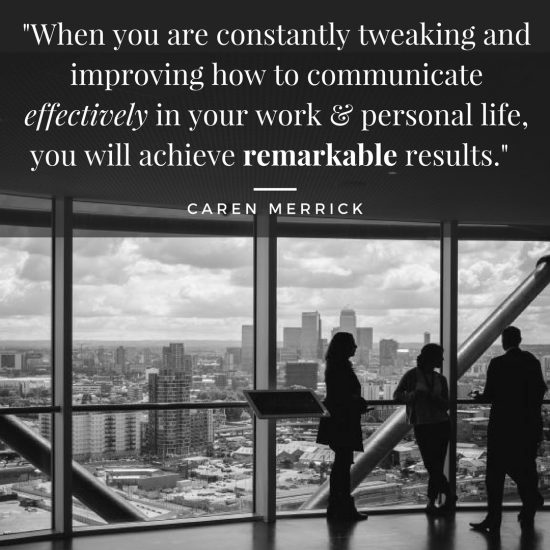For more tips on effective communication, download my free guide, 7 Secrets To Highly Effective Communications
When reflecting on your recent communications, have you experienced any of the following?
- There was disconnect between what you said you wanted from your team and what they delivered.
- You were denied a promotion that you deserved (and requested).
- Your client declined a new service you proposed.
- Your board rejected your new initiative.
All of us know the sting of disappointment when our communication efforts fail to achieve our objectives.
And no matter what age or stage we are in our careers, each of us can be more effective in our communications – we just need to be reminded how.
If some of your recent communications have left you or your audience underwhelmed, see if you are making one, or all of these 3 mistakes:
1. You don’t know how to answer the #1 question of your audience: “What’s in it for me?”
This sounds like it portrays your audience as selfish or self-absorbed, but answering this question is really just a way of disciplining yourself to understand what motivates them – internally and externally. You need to imagine what it is like to walk a mile in the shoes of your audience.
Answering the big “what’s in it for me?” question before you communicate helps you empathize and powerfully connect and engage with your audience, an essential ingredient in effective communications, according to Lindsey Pollak. The more you can empathize with your audience, the more you will connect and build trust, which is essential to any relationship.
Here are a few questions about your audience will give you focus:
- What are their hopes and dreams?
- What is their definition of success in this circumstance?
- What problems can you help them solve?
- What would become possible for them if they accept what you are proposing?
Knowing what your audience wants makes you relatable and shows you care, according to Alexandra Levit.
It’s amazing what a bit of preparation here can do for you. Whether it’s launching a new product, business, announcing a new compensation structure for your management team, or even asking for a big promotion, you must do the analysis to find the benefit for your audience as you prepare.
Often, there is a lot of intersection between what benefits your audience and you, but start with them!
2. You don’t provide compelling evidence
How can you persuade others when you don’t back up your case with logic, facts, or personal experience?
Liz Strauss, of Successful Blog shares a formula that helped grow a company from $9M to $35M in just three years:
“In a company where I once worked, we managed by the jury system — that’s what we called it. It worked like this. Every person on the management team was responsible for championing his or her area of expertise. If a person wanted the group to make a decision, he or she presented the decision, possible choices, and resulting outcomes. The rest of the team asked questions much like a board of directors.”
When making proposals, are you using the metrics readily available to you? There are numerous sources and plenty of data readily accessible to gather facts and logic: comparative analysis of competitors, data from industry leaders, personal anecdotes, customer or expert feedback, industry trends, etc. – this sounds obvious, but we’ve all been in meetings or conversations where proposals are made (and decisions requested) without logic, data, or anecdotes to back it up.
If you want a promotion, are you keeping an updated record on your achievements each quarter? Do you measure and quantify these achievements to show progress?
I’m not suggesting you overwhelm your audience with data, but you do need some. Select what you believe is most impactful and relevant to make your case.
3. You don’t anticipate or plan for objections or resistance
If you’ve done the homework in #1, you are better prepared to identify or imagine what these objections would be, so you can better answer them during a conversation.
Whatever your objective for the communications is, when you consider and counteract opposing arguments, you strengthen your own argument.
According to Rhett Power, Co-Founder of Wild Creations:
“Give the Other Side a chance – It might take some creativity on your part, but find something about the other person’s view to support. This immediately makes for a friendlier atmosphere and the other person is more likely to give credence to your point of view.”
Don’t forget that when you encounter an objection, this is part of the conversation where you need to demonstrate your strongest people skills – and that means paying attention and truly listening, according to Jacquelyn Smith.
If you want to be more effective in your communications, ask yourself if you are making these three mistakes and put some of these ideas into action.
When you are constantly tweaking and improving how to communicate effectively in your work and personal life, you will achieve remarkable results.
— CLICK TO TWEET —![]()







